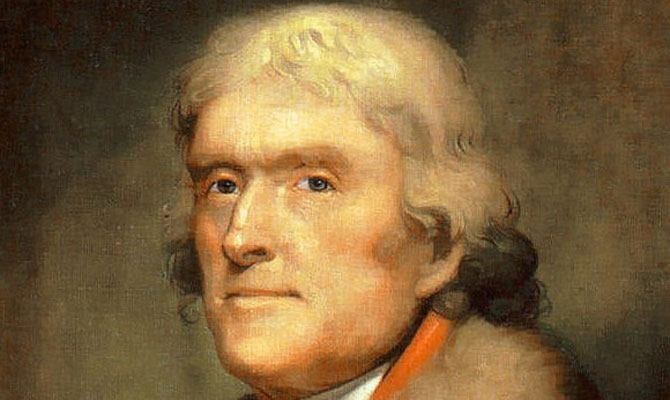The Daily Meal Hall Of Fame: Thomas Jefferson
With the help of The Daily Meal Council, we have selected ten key figures in the history of food to honor this year in our Hall of Fame. Here, Virginia-based Council member Patrick Evans-Hylton, a journalist, author, and food historian, explains why our nation's third president, the estimable Thomas Jefferson, belongs on the roster.
The New World was a little less new when Thomas Jefferson (1743–1826) was born, some 130 years after English explorers first set foot in what would become Virginia.
One of the signers of the Declaration of Independence, he trained as an attorney and served in the House of Burgesses (the first elected legislative assembly in North America) and the Virginia House of Delegates; he also became governor of Virginia, a member of Congress, our minister to France, the secretary of state, the vice president, and the third president of the United States.
He was also, if you'll pardon the expression, America's First Foodie. [pullquote:left]
So many of the foods and foodways we take for granted today were rare or exotic — even scandalous — in the 18th century. Jefferson pioneered the way in making many delicacies mainstream.
His legendary garden at Monticello, his estate outside Charlottesville, produced more than 250 different varieties of vegetables and herbs. Jefferson favored vegetables over meat, writing in 1819, "I have lived temperately, eating little animal food, and that not as an aliment, so much as a condiment for the vegetables which constitute my principal diet."
The pea was Jefferson's favorite vegetable, and he grew 19 varieties at Monticello. Each spring, he held a competition with area gentlemen farmers to see who could produce the first pea of the season, with a dinner to follow featuring the legume.
When it came to vegetables, he was also a little edgy. Tomatoes (or tomatas, as he wrote) weren't common in the 18th century; many folks regarded them suspiciously because the plant is a member of the poisonous nightshade family. The Miller-Claytor House in Lynchburg, Virginia, built in 1791, is colloquially called the Tomato House because local legend has it that Jefferson shocked people there by eating a tomato to dispel such rumors.
Known in India and China, the eggplant was foreign to early Americans. Jefferson is credited with bringing the first here when he received one as a gift from an acquaintance in France in 1806.
On their legendary transcontinental expedition following the Louisiana Purchase in 1803, Virginians Meriwether Lewis and William Clark discovered some 300 new plant species, many of them edible. Jefferson favored a dwarf corn plant found growing on the Northern Plains, which he named Pawnee or Pani corn for a native tribe the explorers encountered. He grew — and ate — the two-foot-tall diminutive maize at Monticello.
Jefferson loved his sweets, too: ice cream at Monticello made from farm fresh cream and eggs with sugar, and flavorings frozen on ice harvested from the nearby Rivanna River.
While Jefferson treasured the foods of his native Virginia, his travels to Europe and his service as minister to France opened his eyes to a new culinary world. Patrick Henry noted that Jefferson "came home from France so Frenchified that he abjured his native victuals." Jefferson himself said his culinary outlook was influenced by his time there, but he held to his roots; his cooking style was described as half-Virginian and half-French.
In Europe, Jefferson relished trying new fruits and cheeses and sampling ice cream, teas, waffles, and macaroni. Souvenirs from his trips included a waffle iron, a pasta machine, and "a stock of macaroni, Parmesan cheese, figs of Marseilles, raisins, almonds, mustard, tarragon vinegar, oil, and anchovies."
Macaroni became a dish he enjoyed serving to guests; it was made with a pasta machine he shipped back to America around 1790. Congressman Manasseh Cutler of Massachusetts wrote this of the dinner menu he attended at the White House on February 6, 1802: "Dined at the President's — Rice soup, round of beef, turkey, mutton, ham, loin of veal, cutlets of mutton or veal, fried eggs, fried beef, a pie called macaroni."
White House dinners were filled with not just imported foods, but local foods, too. Étienne Lemaire, who ran the household and culinary operations of Thomas Jefferson's White House, walked every morning to a Georgetown market to shop; sometimes Jefferson accompanied him.
Jefferson was a lifelong collector of wine, bringing nearly 700 bottles home with him from France. His collection was a consolation to a seemingly rare failure. He wanted to grow Vitis vinifera — European wine grapes — in Virginia and produce quality, European-style wines in America, but the plants could not be nurtured past disease and climate conditions. "Good wine is a necessity of life for me," he said. As president, he had cellars built under the White House that stored some 20,000 bottles; his personal wine bill during his two terms was around $11,000. His Monticello cellar included vintages from France, Germany, Hungary, Italy, Portugal, and Spain. Jefferson also considered beer and cider necessary "table drinks."
There is a joke in the Old Dominion:
Question: How many Virginians does it take to change a light bulb?
Answer: Three; one to change the bulb and two to talk about how good the old bulb was.
And while it's true that we hold on to traditions here with a fierce intensity, we also realize that history is fluid. The groundwork that Jefferson laid — for not only Virginia's but America's culinary scene — is one to be proud of, but also one to build upon.
